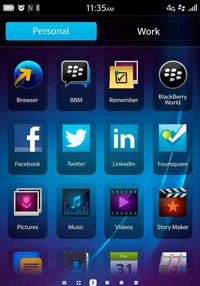Commentary
RIM Redux?
- by Steve Smith , Staff Writer @popeyesm, January 15, 2013
 Look who is back…at least in the quasi-real space of the tech blogosphere. After more missteps than a silent film comedian, Research in Motion
has returned to the limelight, and without mockery or irony. Whatever faux market interest one can surmise from blog posts, the upcoming launch of the BlackBerry 10 operating system and attendant
devices is attracting curiosity at least.
Look who is back…at least in the quasi-real space of the tech blogosphere. After more missteps than a silent film comedian, Research in Motion
has returned to the limelight, and without mockery or irony. Whatever faux market interest one can surmise from blog posts, the upcoming launch of the BlackBerry 10 operating system and attendant
devices is attracting curiosity at least.
The company announced that its weekend incentive program for developers, the “port-a-thon,” netted 15,000 application submissions in less than 38 hours. RIM was enticing developers to port their apps to the BB 10 OS with both cash and the promise of prizes. One hundred dollars was awarded to each ported app, and developers were entered into a sweepstakes to win development handsets and a trip to its European developer event.
The advance peek that RIM has given developers suggests that the much-maligned and far-fallen company is trying to embrace a market that passed it by years ago and yet retain its brand roots in business-ready use cases and communications. The video demos show more than a passing resemblance to the old Web OS in that it emphasized multitasked tiles and a unified messaging “hub.” Much of the core functionality still seems aimed at managing people, contacts and communications and calendaring. After its Playbook tablet debacle and other attempts to reach into the consumer market, RIM appears to be convinced at last that it can't fix RIM by not being RIM.
There are a few cool little tricks to the OS, none of which are enough to sell the new OS and phones. The keyboard is supposed to have personalized autocomplete, and it allows you to toss the fully formed words literally at the text entry box. The camera actually records snapshots in multiple frames so you can identify just the right moment when your eyes were open, not closed, or when the wiffle ball just made contact with Uncle Jim’s crotch.
If there is one very strong business appeal in this phone, it is its ability to truly segregate personal from work phone. You literally fall into a different mode, with separate apps -- even discrete apps stores and contact lists that are inaccessible to the other mode. It addresses squarely the BYOD (Bring Your Own Device) IT phenomenon.
My gut tells me that like Microsoft’s play into the U.S. market, RIM’s is a case of good ideas coming too late. It seems unlikely that most users will opt into a new app ecosystem at this point. And just as the Windows Phone 8’s Live real-time info panes and high levels of personalization are well-imagined, RIM’s good ideas could and should find their way into the dominant OSes in a generation or two. Kantar Media last estimated that the BlackBerry brand holds now only 1.6% of the American smartphone market. In its overseas strongholds, RIM also saw sharp declines, down to 7.9% in the UK.
RIM’s comeback strategy may be in a no-win situation. The infiltration of app-based phones into the enterprise was fueled by consumer enthusiasm for the platforms, making it increasingly difficult for companies to resist accommodating Android and iOS. But much of this model seems to be aimed at appealing to IT departments that have fond memories of the RIM days, but precious few devices still using the platform.



